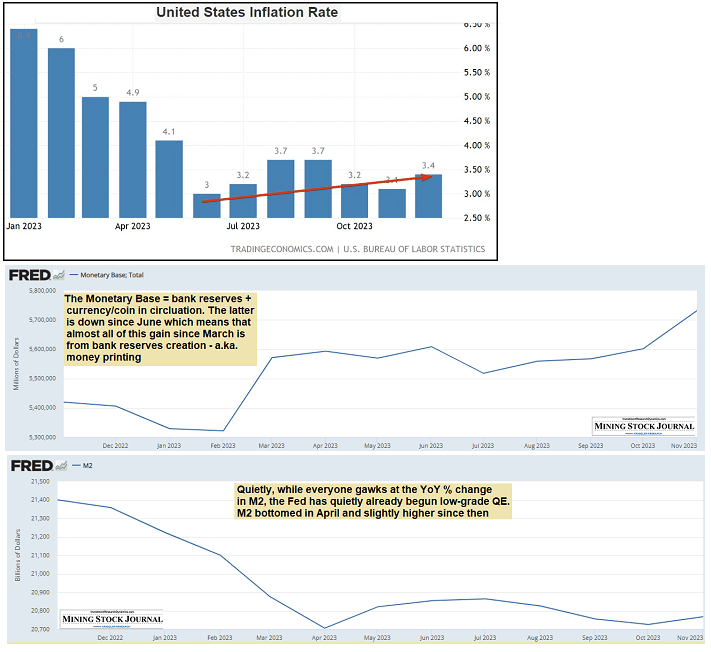deepblue4you
I find it quite amusing that the market believes inflation is tied to rates – the propagandists at the Fed did their job there. Distract while creating bank reserves (print money) out of plain sight.
The Monetary Base is up over 7% since March. M2 is also a bit higher. This is why the rate of inflation has been slowly rising again since June.
It’s also why gold is up 7% and silver is up 2% since the end of June (silver is up 15.9% since early March).

The primary driver of my bull thesis is the shift in the Fed’s monetary policy. It was only a matter of time before this occurred.
The Fed informally “pivoted” away from hiking rates at its November FOMC meeting. The markets immediately began to price several rate cuts in 2024 into stock valuations and bond yields.
“Follow the money” – While most observers are watching what the Fed does with interest rates, few have noticed that the Fed stopped shrinking the money supply in response to the regional bank crisis in March 2023.
In fact, the M2 measure of the money supply has actually increased slightly since April 2023 (while everyone merely glares at the YoY % change in M2 that circulates social media).
In addition, the Monetary Base, consisting of bank reserves and coin/currency in circulation, has increased over 7% since March 2023. This is the primary reason why the price of gold ran from $1,825 in March to $2,070 by year-end 2023.
Money printing – much more so than changes in interest rates – is the fuel that drives precious metals prices higher.
While the economy is likely headed into a nasty recession this year (many sectors of the economy, like manufacturing, were already contracting during 2023), the primary factors that dictate Fed policy are the health of the banking system and the monetization of new Treasury bond issuance. Both factors will need to be addressed, in my opinion, with more money printing.
Although the Fed’s “dual mandate” is to use its monetary policy to promote stable prices and full employment, its first priority is to prevent the “too big to fail” banks from collapsing.
We saw this in 2008, again in 2020 and again in March 2023. In 2023, in response to the collapse of some big regional banks due outflow of checking and savings account funds from banks into money market funds, the Fed swiftly printed $400 billion and injected it into the banking system.
In addition, it made available a “QE-like” facility called the “Bank Term Funding Program” which made funds – money created by the Fed – available to all banks.
The $400 billion was removed by late June. But growth in the Monetary Base between March and the end of November (the most recent money supply report) shows that the Fed actually increased bank reserves by $410 billion.
Very little of this is explained by the change in the level of currency/coin in circulation. This means that it used various “back door” liquidity facilities to replace the $400 billion it printed and then removed, plus it added an additional $410 billion, of which only $147 billion is explained by the Bank Term Funding Program.
In other words, the Fed is opaquely creating banks reserves (aka “printing money”) to address a burgeoning liquidity problem in the banking system.
But the Fed will also have to help fund new Treasury bond issuance at some point this year. Over the next twelve months, an unprecedented $8.2 trillion in Treasury bonds will have to be refinanced.
In addition, based on the first quarter of the Government’s fiscal year (starting October 1, 2023), the Government’s spending deficit on an annualized basis would be over $2 trillion.
This is additional new debt issuance that will have to be funded – a task made more difficult by the fact that our Government’s biggest foreign financiers (China, Japan and OPEC) have been reducing their participation in Treasury auctions.
Unless the Fed can find investors large enough to replace the missing foreign investment capital, it will either have to be the buyer of last resort or risk watching Treasury yields soar to a level that might induce foreign capital back to the table at Treasury bond auctions.
Because considerably higher interest rates would throw the U.S. into an economic depression, the second motive for renewed money printing in 2024 will thus be a requirement for the Fed to bridge the gap between the supply and demand for Treasuries.
I strongly believe that the financial and economic fundamentals are set up quite similarly, only much worse, to the conditions in 2008 that led to the Great Financial Crisis.
As such, I also believe that the Fed’s response to the next full-blown financial system crisis will be much larger than its responses in 2008 and 2020. This should result in a cyclical bull move that I believe will be bigger than the move from late 2008 to mid-2011.
Editor’s Note: The summary bullets for this article were chosen by Seeking Alpha editors.



